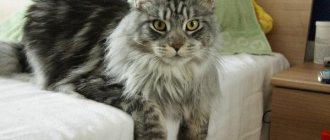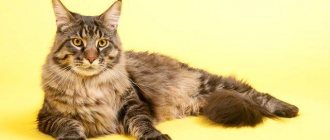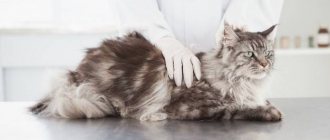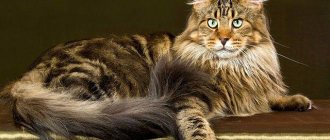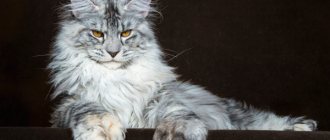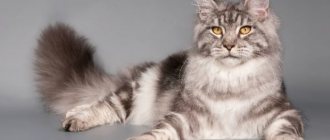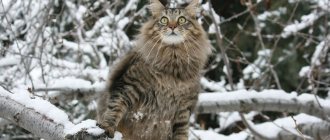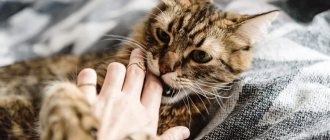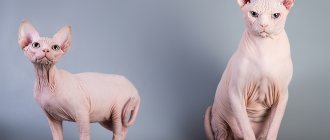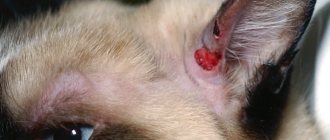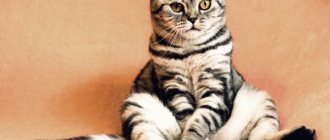Some people don’t even realize how magnificent, beautiful, majestic the Maine Coon breed is.
Many have heard that a cat of this type has thick fluffy fur, even more similar to a raccoon than to the cat you are used to.
Very large animals. The mass of some individuals reaches 15 kilos, and the length from nose to tip of tail is more than a meter.
If translated from English, the Maine Coon breed literally means “raccoon from Maine.” Cats are native to North America. They were even recognized as national animals.
This breed is only gaining popularity in our country: nurseries are opening, competitions and exhibitions are being held, and champions are appearing.
Causes and symptoms
Most often, constipation is not an independent disease, but a sign of pathology. It occurs as a result of infection by parasites, disruption of internal organs, etc.
However, sometimes constipation occurs due to improper care or individual characteristics.
Problems with emptying may occur due to the following reasons:
- Fluid deficiency. Feces become dry and cannot move properly through the gastrointestinal tract.
- Incorrect feeding. Due to the lack of coarse fibers, muscles contract less well.
- Helminthiasis. With severe infestation, obstruction may occur.
- Hairballs in the intestines. Dense mats cause partial or complete obstruction.
- Taking medications. This reaction can be caused by diuretics, as well as drugs with calcium and iron.
- Sedentary lifestyle. Risks deterioration of muscle function.
- Stress. Often found in small kittens.
- Improper functioning of the central nervous system. May be associated with spinal injury. The body simply does not receive signals prompting defecation.
- Postoperative period.
- Inflammatory processes. Due to tissue swelling, the intestinal lumen narrows.
- Neoplasms. Partially block the movement of feces.
Constipation occurs when peristalsis is impaired. The latter may be associated with congenital anomalies of the gastrointestinal tract. Difficulty defecating is more common in pregnant cats.
Sometimes recurring constipation is associated with endocrine diseases and metabolic disorders.
If there is difficulty in emptying, the following symptoms are observed:
- Retention of stool.
- Poor appetite. The animal refuses to eat on its own and loses weight. A cat may show interest at the sight of food but turn away from the bowl.
- Deterioration in the appearance of the coat. Hair becomes dull and falls out. This is due to intoxication.
- Discharge from the eyes. May be sticky and brown.
- Nausea and vomiting. Occurs in severe condition due to intoxication.
- Change in the shape of feces. Feces may become band-shaped if a tumor is present.
- Discomfort when visiting the tray. The cat looks for a place for a long time and even tries to defecate, but in the process it gets worried and growls.
- Bloating. Increased gas formation may occur.
- Dry feces Sometimes the feces are so hard that they damage the mucous membranes of the gastrointestinal tract. As a result, the intestines become inflamed. First, mucus is released along with the masses, and later - blood.
The most alarming sign is a hard and painful stomach. In such cases, the pet may often change position, trying to find a comfortable position. Gait changes due to pain.
The animal becomes irritable, does not allow itself to be touched, growls or meows pitifully. Symptoms may indicate intestinal obstruction, which requires immediate veterinary attention.
"Sturgeon of the second freshness"
Maine Coons are not particularly good at distinguishing tastes. For example, during evolution, cats have lost the receptors that distinguish sweet tastes, but at the same time they experience real pleasure from fatty foods. Simply put, fat plays the same role for them as sweets and desserts do for us. However, cats have no difficulties with their sense of smell; their sense of smell is impeccable. We won’t even turn our noses at a slightly stale product, but cats will turn it away with complete contempt. And this is no longer a whim. The stomachs of cats, unlike, for example, the stomachs of dogs, do not secrete special substances that cope with putrefactive bacteria, because in nature cats do not eat carrion - only fresh meat. Consuming stale food for cats can result in serious poisoning. Therefore, instinct makes these animals avoid stale food.
How often should cats go to the toilet?
The frequency of visiting the tray depends on the age of the animal and its lifestyle. Up to 3 weeks of age, kittens may have bowel movements irregularly. They do this after stimulation by their mother.
After 3 weeks, the gastrointestinal tract is already formed so much that the kitten is able to go to the toilet on its own. This happens 3-6 times a day.
After 3 months, the animal begins to visit the litter tray 2-3 times a day. The frequency may vary depending on how active the cat is. Adult cats do this 1-2 times a day. In older pets, peristalsis is impaired due to age, so with a sedentary lifestyle, they can only go to the litter box once every 2 days.
The absence of defecation for 3 days, regardless of the age and condition of the animal, is an alarming symptom. In the case of kittens, irreversible changes can occur within 8-12 hours.
Morning (breakfast)
Beef, turkey, beef heart - raw, finely chopped or rolled on a coarse grater, frozen in the refrigerator for at least three days or chicken (boiled breast), I give all other “spare parts” of the chicken raw (stomachs, necks, hearts, liver ...) canned meat for children (don’t buy a lot at once, try one jar at a time, your little one will like it), I use Dr. Klauder canned food. Now I am very pleased with our domestic canned food Best Dinner, I recommend it. Both kittens and adult Maine Coons.
Dry food and plenty of water are freely available throughout the day. It is advisable to purchase a bowl of water of one and a half to two liters, no less, since these comrades love to splash around in it and put toys in it. Change the water EVERY day!! If you see that paws have been washed in it, change it! If you have washed toys, change it! If you wash a piece of meat, change it! Place a bowl of water away from dry food - the food may get wet.
First aid for constipation
If there is no bowel movement for a long time, the first step is to stop giving the animal food. A cat will not die from hunger in 2-3 days, but it can from a ruptured intestine. Monitor your water consumption.
Dehydration is more dangerous than hunger. If your pet does not drink, give him 5-10 ml each time. Sometimes it is advisable to inject saline solution to compensate for fluid deficiency.
It is prohibited to self-prescribe laxatives. This is especially true for drugs with irritating effects, incl. saline solution. This effect may increase inflammation.
Before receiving veterinary help, you can give your animal Vaseline oil. Its dosage is large and the taste is unpleasant, so call an assistant. It will fix the cat.
It is forbidden to give Vaseline oil if there are signs of intestinal obstruction. If your animal vomits after taking the product, contact the clinic immediately. Oil can only help at the stage when the stool is still soft, so it should not replace full-fledged treatment.
If small kittens do not have bowel movements due to insufficient care from the mother, massage is recommended. To do this, take a piece of gauze and moisten it with warm water.
The belly is massaged with the cloth, gradually moving lower towards the anus. This way you stimulate the animal to empty its bladder and bowels.
ZooForum: Maine Coon kitten 3 months old: diarrhea and vomiting – ZooForum
(others can give advice in a PM, indicating that the advice is not given by a veterinarian. But the forum is not responsible for THESE advice.)
Maine Coon kitten 3 months old: diarrhea and vomiting
We first fed him kitiket from bags (he ate up to 3 bags a day), the cat almost immediately began to have diarrhea with the smell of almost this very kitiket.
We switched to feeding minced beef, cottage cheese and whiskey bread for kittens. The diarrhea continued, became more liquid, + vomiting was added.
If you were able to buy a Maine Coon, then you obviously do not experience financial difficulties and will be able to feed him better quality food. We don’t even feed animal-protective cats that are selected for the device so that they don’t get sick. And don’t mix industrial feed and natural food, this is a very unhealthy activity. Choose high-quality premium canned food, preferably for kittens with sensitive digestion. It is usually recommended to transfer coons to land no earlier than six months.
To the clinic - URGENTLY. Only good ones! Where are you located geographically? I recommend Zoovet, Belanta, White Fang. Looks like the kitten has a virus. This is serious!
I had cats before, but they were all nobles. on the topic “feed crap” - no question, tell me what to feed. By the way, tell me at the same time what a “good clinic” is. Otherwise, the previous cat was treated to death with a huge dose of antibiotics.
The cat was fed a quarter of a phtholazole tablet, his diet was restricted, he was given friscas crackers, and his eyes were smeared with tetracycline. The animal felt better, it only pooped once during the night (badly, after all), it stopped vomiting, its eyes opened almost completely, its mood and tone improved.
Read it. Let's just say friscas is even worse than kiteket. You apparently buy food for your kitten at the supermarket. But you have to buy it in specialized stores. There you and n
Source
Treatment methods at home
Most of the procedures can be performed at home. Before this, you need to visit a veterinarian to make sure there are no complications and get a prescription.
To make a diagnosis, your doctor may perform an ultrasound of the abdomen. Inpatient treatment is required for a pet only if there is obstruction or in advanced cases.
Nutritional features and medicinal feeds
If you experience regular constipation, you must make changes to your diet. In the early stages, this can completely solve the problem. In the later stages, a change in diet is included in the therapeutic course.
When feeding natural products, you should adhere to the following recommendations:
- Don't offer your cat bones. The fragments can injure the mucous membranes of the gastrointestinal tract. Even if the animal digests the bone tissue, it will turn back into a solid mass when it comes out. At best, this will cause severe discomfort during bowel movements, at worst, it will cause obstruction.
- Offer your cat liver in small quantities daily or every 2-3 days. The by-product acts as a laxative. It contains a lot of fat, so it is important not to overdo it. 1-2 tsp is enough.
- Add vegetable oils to your food. They will act as a natural lubricant, making bowel movements smoother. You can introduce raw sunflower seeds into your diet. You should not give your cat more than 1 tsp. oils per day, because this can trigger the development of liver diseases.
- Replace grains with vegetables and herbs. Be sure to include pumpkin in your menu. It is 90% water. 3% is occupied by coarse fibers. The liquid facilitates the passage of feces through the gastrointestinal tract, and fiber stimulates muscle contractions.
- Remove all potentially dangerous foods from your diet. This is especially true for human food: sweets, spices, smoked meats, etc. The cat's body is not adapted to absorb sugars. Desserts increase the load on the pancreas, which leads to the development of pancreatitis and constipation. Spices irritate the intestinal mucous membranes.
If you prefer pelleted diets, then during exacerbations your cat should be given food labeled as medicinal. Such products are produced by the brands Royal Canin, Hill's, Eukanuba, Farmina, etc.
It is recommended to prefer the latter, as they belong to the super-premium category. Such feeds contain more available nutrients and are less likely to cause side effects from other organs and systems.
At first, it is better to give your cat canned food and pouches. They contain more fluid and make bowel movements easier.
Using vegetable oil
Cats are allowed to give sunflower, olive, mustard and linseed oils. The dose is selected by the veterinarian, but it should not exceed 1.5 ml per 1 kg of weight.
It is advisable to give your pet oil along with vegetables. If this does not work, you can sip the animal from a syringe. Do not mix oils with dairy products.
The best laxatives
For constipation in a cat, the following laxatives are most often used:
- Duphalac. Syrup based on galactose and lactulose. The active substances reach the intestinal contents, oxidize the liquid and thus soften the feces. The syrup increases the pressure inside the rectum and enhances peristalsis. The drug begins to act on the first day after starting administration.
- Microlax. Microenema lubricates the walls of the gastrointestinal tract, softens stool, enhances muscle contractions and facilitates the removal of feces. In most cases, defecation occurs within 10-30 minutes after using the drug. The product should not be used for intestinal damage.
- Normaze. The syrup contains lactulose. Normaze penetrates into the stool and softens it. The volume of feces increases, which provokes their movement. Defecation occurs within 24 hours after administration.
Application of herbal medicine
The following remedies can be used to combat constipation:
- Nux Vomica (drops). The drug is most effective when a foreign object or hairball enters the gastrointestinal tract.
- Hepar sulphur. The product is used for constipation that develops against the background of a sedentary lifestyle.
- Herbal collection. You can make your own from centaury, wormwood, coriander and black elderberry. The ingredients are mixed in equal proportions. 1 tbsp. l. collection, pour 250 ml of water and place in a water bath. The mixture is boiled with the lid closed for 20 minutes. After filtering and cooling, the cat is given 10-15 ml. The procedure can be repeated up to 3 times a day.
How to give an enema
It is necessary to treat an animal with an enema only if the constipation is not chronic and lasts for no more than 3 days. The procedure is unsafe. If you are careless, you will harm the animal. If you have no experience, it is better to ask a veterinarian for help.
To carry out the procedure, you will need a mini-enema with a thin spout.
They lock themselves with the cat in an isolated room. It is advisable to enlist the help of an assistant. The enema spout is lubricated with Vaseline or oil. The animal's tail is lifted and the device is inserted into the anus 4-5 cm.
In the process, you may feel like you've hit something solid. In this case, you should not press, because... it could be stool. The drug is administered slowly, without removing the enema for another 10 seconds after completion.
After the procedure, you need to observe the animal. Within 2-3 hours the pet should feel better. If existing symptoms intensify or new ones appear, contact your veterinarian immediately.
Using Vaseline Oil
Vaseline oil facilitates the movement of feces and reduces trauma to the mucous membranes. It is given with food or poured into the animal’s mouth with a syringe without a needle. The advantage of petroleum jelly is that it is not absorbed by the upper gastrointestinal tract.
Unchanged, it enters the intestines and softens the stool. The drug is given up to 3 times a day. It is forbidden to mix Vaseline oil with vegetable oils.
Typical Maine Coon diseases
Maine Coon cats are the largest among domestic felines. But like all mammals, there is a risk of loose stools. When this unpleasant symptom appears, you should pay attention to several characteristics: consistency, smell, frequency of bowel movements, color and the presence of impurities in the stool.
The semi-longhaired North American cat is currently one of the largest and most ancient breeds of natural origin. The breed is perfectly adapted to survive in the harsh climatic conditions of New England, and its distinguishing feature is good health and fairly high levels of endurance.
The hereditary category for the Maine Coon includes some pathologies of the musculoskeletal system, skin diseases, diseases of the urinary and cardiovascular systems.
Diseases of the musculoskeletal system
What health does a Maine Coon have?
The Maine Coon breed is considered aboriginal; it was formed without human intervention in the American state of Maine. The climate of this area is quite harsh, so only strong individuals could survive there.
This is why the Maine Coon has excellent health. The breed is not prone to genetic diseases and has virtually no birth defects.
Like all domestic cats, they can suffer from typical diseases, but if the owner treats the health of his pet correctly, the risk of disease is minimized.
Common diseases
What to do if your cat is constipated during sterilization
Constipation after sterilization most often occurs due to anesthesia. This is a natural effect of the drug, so it is recommended not to feed the animal 10-12 hours before castration.
Rarely, fecal retention is associated with damage to the rectal wall during surgery. In this case, the only way to help your pet is through surgery.
To treat constipation, you can give your animal a mild laxative or Vaseline oil. It is necessary to temporarily replace the tray: there should be no coarse filler inside that could damage the seams. If an animal is faced with pain, it may endure to avoid discomfort.
Prevention measures
To prevent digestive disorders, the following recommendations should be followed:
- Brush your pet regularly. It is advisable to use a furminator for this to remove most of the dead hair. During shedding, you can offer your pet special food or paste to remove hair.
- Provide the animal with adequate nutrition. Your diet should include sources of fiber. Do not feed your pet only canned food and pates.
- Water must be freely available. It is better to purchase large bowls, because... the animal can save water.
- Plant special cat grass. It will help cleanse the intestines and stimulate peristalsis.
- Apply flea treatment and deworming every 3-6 months.
- Provide physical activity. Put up a big cat tree, buy toys, and exercise with the animal more often.
Additionally
Vitamins - specialized, preferably with the addition of calcium and taurine.
Chondroprotectors for bones and joints are a must! Likes: Beaphar Junior Cal; Beaphar Irish Cal; Anivital CaniAgil AniVital CaniAgil. There is a wide choice on the market, just read on the Internet, but be sure to add medications for bones and joints to the diet of a growing Maine Coon.
Sometimes your favorite Maine Coon may ask for something from your table. It could be a piece of sausage or cheese, milk porridge or dumpling. For example, I have a cat who really loves baked goods and fresh bread. Do not deny him this little pleasure, which will increase many times over if you let him lick your plate.
If you decide to switch completely to natural feeding, do not do it suddenly. Everything is gradual. And remember, with natural feeding (without adding dry food), a complex of vitamins is required: a complex of vitamins and minerals, namely: calcium preparations, vitamins for wool, B vitamins, ascorbic acid, taurine, essential unsaturated fatty amino acids Omega-3 and Omega-6, microelements.
A common type of natural food, the so-called “Kun porridge”, is one of the recipes:
1 kg. chicken neck, 100 g chicken liver, 100 g. chicken stomachs, 100 gr. chicken hearts, 400 g beef, 400 g. chicken breast, large carrots, half a bunch of lettuce, 10 per. eggs
Grind everything coarsely in a meat grinder or chop finely, mix, divide into portions and place in the freezer. You can feed breakfast and dinner three times. Add vitamins, protectors, vetom to the “porridge” - everything that is needed for the normal growth of the Maine Coon.
